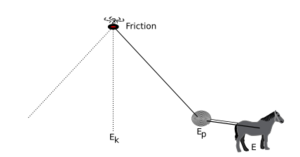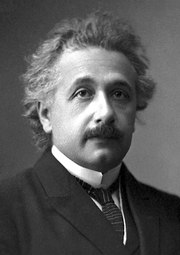Mass-energy equivalence facts for kids
E=mc2 is a super famous idea from Albert Einstein. It's a special equation in physics and math. It shows how mass (the stuff things are made of) can turn into energy, and how energy can turn into mass.
In the equation, "E" stands for energy. Energy is like a power that lets things change other things. For example, a heavy brick held high has lots of energy. If it falls on an egg, it can break it! A light feather doesn't have enough energy to do that.
Contents
What is Energy?
Energy comes in different forms. Imagine a pendulum swinging back and forth. This helps us understand two main types of energy:
- Potential energy: This is stored energy. An object has potential energy because of its position. Think of the pendulum when it's pulled up high. It has potential energy because it can fall down.
- Kinetic energy: This is the energy of movement. As the pendulum swings down, it moves faster. The faster it goes, the more kinetic energy it has.
When the pendulum swings, its potential energy changes into kinetic energy. Then, as it swings up the other side, its kinetic energy changes back into potential energy. If there were no friction (like air rubbing on it), it would swing forever!
For a long time, scientists thought that energy could not be made or destroyed. It just changed forms. This is called the "conservation law of energy." For example, when you throw a ball, the energy from your hand moves to the ball. The total amount of energy stays the same.
Mass and Energy are Connected
But then Einstein came along! He showed that mass and energy are deeply connected. His famous equation, E = mc2, explains this link.
In the equation, "m" stands for mass. Mass is how much "stuff" an object has. A big rock has more mass than a small pebble. The more protons and neutrons an object has, the more mass it has.
Mass is different from weight. Your weight changes depending on how strong gravity is. You'd weigh more on Jupiter because it's huge, but your mass would be the same. Mass is the actual amount of matter in you.
How Mass Becomes Energy
Sometimes, a tiny bit of mass can turn into a huge amount of energy. This happens in something called radioactivity.
For example, uranium is a special element. Its atoms can break apart. When a uranium atom breaks, it loses a tiny bit of its mass. This lost mass doesn't just disappear; it turns into a lot of energy!
A famous example of this is the "Little Boy" atomic bomb that exploded over Hiroshima. In that event, only about two-thirds of a gram of uranium mass was changed into energy. But that tiny amount of mass released an enormous amount of energy!
How Energy Becomes Mass
Energy can also turn into mass. This is harder to notice in everyday life. If you push a toy car, it gets easier to push the faster it goes, right? But if you could push something almost as fast as light, you'd find it gets harder and harder to speed it up. That's because as an object moves faster, its mass actually increases!
This change in mass is tiny at normal speeds, so we don't feel it. But as things get closer to the speed of light, the mass increases a lot. It would take an endless amount of energy to make anything with mass go at the speed of light. That's why nothing with mass can ever reach light speed!
Images for kids
-
Mass near the M87* black hole is converted into a very energetic astrophysical jet, stretching five thousand light years
-
In the revised English edition of Isaac Newton's Opticks, published in 1717, Newton speculated on the equivalence of mass and light.
-
Photo of Albert Einstein in 1921
-
The equation in Albert Einstein's own handwriting from 1912
-
The popular connection between Einstein, the equation E = mc2, and the atomic bomb was prominently indicated on the cover of Time magazine in July 1946.
See also
 In Spanish: Equivalencia entre masa y energía para niños
In Spanish: Equivalencia entre masa y energía para niños









